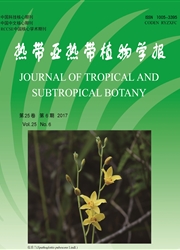

 中文摘要:
中文摘要:
为了解中亚热带森林土壤的真菌多样性,利用PCR-DGGE分子指纹图谱技术对武夷山国家级自然保护区和建瓯万木林自然保护区内的米槠(Castanopsis carlesii)天然林土壤真菌进行研究。结果表明,中亚热带地区森林土壤真菌群落丰富,土壤真菌的多样性指数、丰富度指数和均匀度指数分别为3.37~3.80、26~29和0.977~0.984。经测序及同源性比对,真菌以担子菌类(Basidiomycota)最多,占总数的35.9%;其次为子囊菌类(Ascomycota),占总数的15.4%;接合菌类(Zygomycota)和半知菌类(Deuteromycota)分别占总数的10.3%和7.7%。主成分分析表明,地点和土层深度共同影响真菌群落组成,其中由地点引起的真菌群落组成差异大于土层深度。土壤真菌多样性指数与土壤铵态氮呈显著正相关,与土壤碳氮比呈显著负相关;丰富度指数和均匀度指数与土壤因子间没有显著的相关性,因此,土壤碳、氮含量是影响土壤真菌群落结构的重要因子。
 英文摘要:
英文摘要:
In order to understand the soil fungal diversity in mid-subtropical forest, the soil fungal community structure ofCastanopsis carlesiinature forests in Wuyi Mountain and Jian’ou Wanmulin Nature Reserves at northern Fujian, eastern China was studied by PCR-DGGE molecular ifngerprint techniques. The results showed that the diversity index, richness index and evenness index of soil fungal in the two subtropical forests were 3.37–3.80, 26–29 and 0.977–0.984, respectively, indicating that the natural forest soil fungal communities were abundant. Thirty-nine fungi species were obtained by sequencing and homologous alignment, among which Basidiomycota were the most, accounting for 35.9%; followed by Ascomycota for 15.4%, then Zygomycota for 10.3% and Deuteromycota for 7.7%. Principal component analysis showed both soil depth and sample location were the major factors influencing fungal community composition, and the effect of location was bigger than soil depth. Correlation analysis showed that soil fungal diversity index had signiifcant positive correlation with ammonium nitrogen content and negative with carbon nitrogen ratio, nevertheless, the community richness index and evenness index showed no signiifcant relation with the soil factors. So, the carbon and nitrogen contents in soil were important factors affecting the soil fungal community structure.
 同期刊论文项目
同期刊论文项目
 同项目期刊论文
同项目期刊论文
 Effects of leaf littertannin on soil ammonium and nitrate content in two different forest soils of m
Effects of leaf littertannin on soil ammonium and nitrate content in two different forest soils of m 期刊信息
期刊信息
